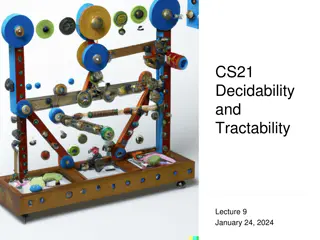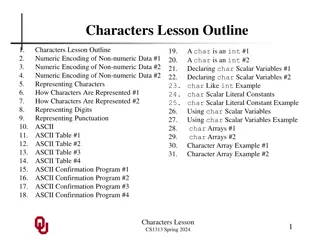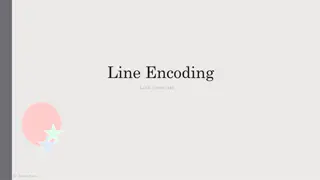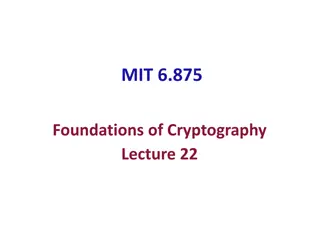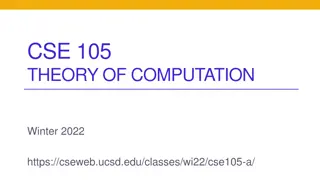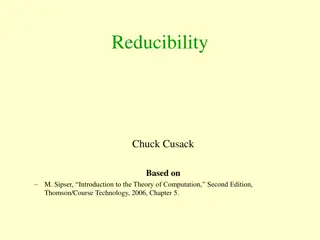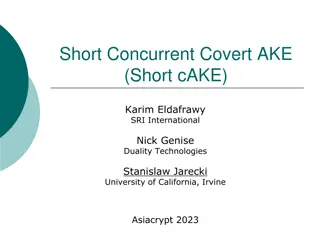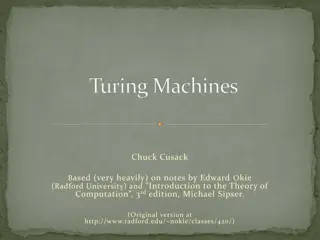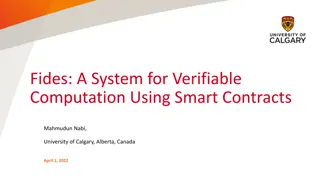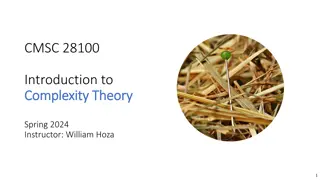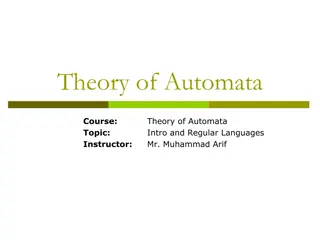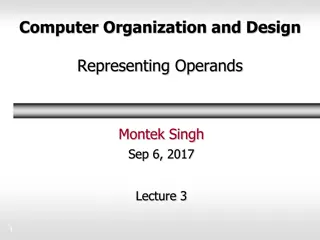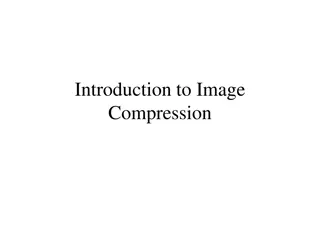Theory of Computation: Decidability and Encoding in CSE 105 Class
Explore the concepts of decidability, encoding, and computational problems in CSE 105 Theory of Computation class. Learn about decision problems, encodings for Turing Machines, framing problems as languages of strings, and examples of computational problems and their encodings. Gain insights into the limits of decision problems and the relationship between decidability and language encoding.
Download Presentation

Please find below an Image/Link to download the presentation.
The content on the website is provided AS IS for your information and personal use only. It may not be sold, licensed, or shared on other websites without obtaining consent from the author.If you encounter any issues during the download, it is possible that the publisher has removed the file from their server.
You are allowed to download the files provided on this website for personal or commercial use, subject to the condition that they are used lawfully. All files are the property of their respective owners.
The content on the website is provided AS IS for your information and personal use only. It may not be sold, licensed, or shared on other websites without obtaining consent from the author.
E N D
Presentation Transcript
CSE 105 THEORY OF COMPUTATION Spring 2019 https://cseweb.ucsd.edu/classes/sp19/cse105-a/
Today's learning goals Sipser Ch 4.1 Explain what it means for a problem to be decidable. Justify the use of encoding. Give examples of decidable problems. Use counting arguments to prove the existence of unrecognizable (undecidable) languages.
At start of CSE 105 Classification: is input of type A or not? Decision problem Pick a model of computation Study what problems it can solve { w | w is of type A} PRIME = { 2, 3, 5, 7, } SORTED = { <1,3>, <-1, 8, 17> } Prove its limits Decision problems are coded by sets of strings
Encoding input for TMs Sipser p. 159 By definition, TM inputs are strings For inputs that aren't strings, we have to encode the object (represent it as a string) first To define TM M: "On input w 1. .. 2. .. 3. Notation: <O> is the string that represents (encodes) the object O <O1, , On> is the single string that represents the tuple of objects O1, , On
Encoding inputs Payoff: problems we care about can be reframed as languages of strings e.g. "Recognize whether a string is a palindrome." { w | w in {0,1}* and w = wR } e.g. "Check whether a string is accepted by a DFA." { <B,w> | B is a DFA over , w in *, and w is in L(B) } e.g. "Check whether the language of a PDA is infinite." { <A> | A is a PDA and L(A) is infinite}
Encoding inputs Payoff: problems we care about can be reframed as languages of strings e.g. "Recognize whether a string is a palindrome." { w | w in {0,1}* and w = wR } A. This set is regular and decidable. B. This set is regular and not decidable C. This set is nonregular and decidable D. This set is nonregular and not decidable. E. None of the above
Computational problems A computational problem is decidable iff the language encoding the problem instances is decidable
Computational problems Sample computational problems and their encodings: ADFA "Check whether a string is accepted by a DFA." { <B,w> | B is a DFA over , w in *, and w is in L(B) } EDFA "Check whether the language of a DFA is empty." { <A> | A is a DFA over , L(A) is empty } EQDFA "Check whether the languages of two DFA are equal." { <A, B> | A and B are DFA over , L(A) = L(B)} ..
Computational problems Sample computational problems and their encodings: ADFA "Check whether a string is accepted by a DFA." { <B,w> | B is a DFA over , w in *, and w is in L(B) } EDFA "Check whether the language of a DFA is empty." { <A> | A is a DFA over , L(A) is empty } EQDFA "Check whether the languages of two DFA are equal." { <A, B> | A and B are DFA over , L(A) = L(B)} FACT: all of these problems are decidable!
Proving decidability Claim: ADFA is decidable Proof: WTS that { <B,w> | B is a DFA over , w in *, and w is in L(B) } is decidable. Step 1: construction How would you check if w is in L(B)?
Proving decidability A B A. <A, 1> is not in ADFA B. <A, 01> is not in ADFA C. <B, 1> is not in ADFA D. <B, 01> is not in ADFA E. More than one of the above
Proving decidability Define TM M1 by: M1 = "On input <B,w> 1. Check whether input is a valid encoding of a DFA and input string for that DFA. If not, reject. 2. Simulate running B on w (by keeping track of states in B, transition function of B, etc.) 3. When the simulation ends, by finishing to process all of w, check current state of B: if it is final, accept; if it is not, reject."
Proving decidability Step 1: construction Define TM M1 by M1 = "On input <B,w> 1. Check input is a valid encoding of a DFA and input string for that DFA. If not, reject. 2. Simulate running B on w (by keeping track of states in B, transition function of B, etc.) 3. When the simulation ends, by finishing to process all of w, check current state of B: if it is final, accept; if it is not, reject." Step 2: correctness proof WTS (1) L(M1) = ADFA and (2) M1 is a decider.
Proving decidability Claim: EDFA is decidable Proof: WTS that { <A> | A is a DFA over , L(A) is empty } is decidable.
Proving decidability Claim: EDFA is decidable Proof: WTS that { <A> | A is a DFA over , L(A) is empty } is decidable. e.g.< > is in EDFA ; < > is not in EDFA TM deciding EDFA should accept and should reject
Proving decidability Claim: EDFA is decidable Proof: WTS that { <A> | A is a DFA over , L(A) is empty } is decidable. Idea: give high-level description Step 1: construction What condition distinguishes between DFA that accept *some* string and those that don't accept *any*?
Proving decidability Claim: EDFA is decidable Proof: WTS that { <A> | A is a DFA over , L(A) is empty } is decidable. Idea: give high-level description Step 1: construction Breadth first search in transition diagram to look for path from start state to an accepting state What condition distinguishes between DFA that accept *some* string and those that don't accept *any*?
Proving decidability Claim: EDFA is decidable Proof: WTS that { <A> | A is a DFA over , L(A) is empty } is decidable. Idea: give high-level description Step 1: construction Define TM M2 by: M2 = "On input <A>: 1. Check whether input is a valid encoding of a DFA; if not, reject. 2. Mark the start state of A. 3. Repeat until no new states get marked: i. Loop over states of A and mark any unmarked state that has an incoming edge from a marked state. 4. If no final state of A is marked, accept; otherwise, reject.
Proving decidability Step 1: construction Define TM M2 by: M2 = "On input <A>: 1. Check whether input is a valid encoding of a DFA; if not, reject. 2. Mark the state state of A. 3. Repeat until no new states get marked: i. Loop over states of A and mark any unmarked state that has an incoming edge from a marked state. 4. If no final state of A is marked, accept; otherwise, reject. Step 2: correctness proof WTS (1) L(M2) = EDFA and (2) M2 is a decider.
Proving decidability Claim: EQDFA is decidable Proof: WTS that { <A, B> | A, B are DFA over , L(A) = L(B) } is decidable. Idea: give high-level description Step 1: construction Will we be able to simulate A and B? What does set equality mean? Can we use our previous work?
Proving decidability Claim: EQDFA is decidable Proof: WTS that { <A, B> | A, B are DFA over , L(A) = L(B) } is decidable. Idea: give high-level description Step 1: construction Will we be able to simulate A and B? What does set equality mean? Can we use our previous work?
Proving decidability Claim: EQDFA is decidable Proof: WTS that { <A, B> | A, B are DFA over , L(A) = L(B) } is decidable. Idea: give high-level description Step 1: construction Very high-level: Build new DFA recognizing symmetric difference of L(A), L(B). Check if this set is empty.
Proving decidability Claim: EQDFA is decidable Proof: WTS that { <A, B> | A, B are DFA over , L(A) = L(B) } is decidable. Idea: give high-level description Step 1: construction Define TM M3 by: M3 = "On input <A,B>: 1. Check whether input is valid encoding of pair of DFAs; if not, reject. 2. Construct a new DFA, D, from A,B using algorithms for complementing, taking unions of regular languages such that L(D) = symmetric difference of L(A) and L(B). 3. Run machine M2 on <D>. 4. If it accepts, accept; if it rejects, reject."
Proving decidability Step 1: construction Define TM M3 by: M3 = "On input <A,B>: 1. Check whether input is valid encoding of pair of DFAs; if not, reject. 2. Construct a new DFA, D, from A,B using algorithms for complementing, taking unions of regular languages such that L(D) = symmetric difference of L(A) and L(B). 3. Run machine M2 on <D>. 4. If it accepts, accept; if it rejects, reject." Step 2: correctness proof WTS (1) L(M3) = EQDFA and (2) M3 is a decider.
Techniques Sipser 4.1 Subroutines: can use decision procedures of decidable problems as subroutines in other algorithms ADFA EDFA EQDFA Constructions: can use algorithms for constructions as subroutines in other algorithms Converting DFA to DFA recognizing complement (or Kleene star). Converting two DFA/NFA to one recognizing union (or intersection, concatenation). Converting NFA to equivalent DFA. Converting regular expression to equivalent NFA. Converting DFA to equivalent regular expression.
Undecidable? There are many ways to prove that a problem is decidable. How do we find (and prove) that a problem is not decidable?







